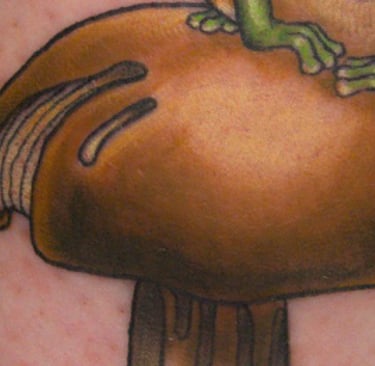Have you ever been interested in getting a custom tattoo design but didn't know where to start? Or maybe you've gotten custom designs before, but when you show up to your appointment the design is nothing like you imagined. As a tattoo artist, I've been on the other side of these interactions and it can be frustrating for both me and my client to have extensive re-draws the day of the appointment. Luckily for clients, I have some tips for streamlining the process and making sure the design matches your vision.
First off, make sure to include as much detail as possible in your initial inquiry! Let's say a client contacts an artist and says they want a bird sitting on a branch. From the artist's perspective, this makes it seem like the client isn't particular about the bird or the type of branch. But little do they know the piece is a memorial piece for the clients grandma, and it needs to be a dove in a pear tree! The client shows up to the appointment disappointed when the artist's drawing is nowhere close to a dove or a pear tree.
Here's a quick list of the absolute essentials you should include when first contacting your artist:
What elements you want in the tattoo, including any crucial elements or details
If you want a color or black and grey tattoo
Where you want the tattoo
How large you want the tattoo (a range or rough size estimate is usually fine)
As an artist, I try to ask as many follow-up questions as possible but sometimes I don't know which questions are important. For example, if a client requested a tattoo of a football, but didn't specify that they wanted a specific brand of football, then I wouldn't know to ask them for that information.
How can you avoid this? Think carefully about each element you want in the tattoo, and try to visualize what they might look like.
Here are some good descriptors to get you started:
Specific names of the element (i.e. garden roses, ocelot, ferns instead of rose, cat, or plant)
Essential features that must be included (i.e. a specific marking on a pet portrait)
Including example photos, and describing what you like about the photo (i.e. I like the style of this phoenix, but want the pose more like this other phoenix)
If you want the elements of the tattoo arranged in a specific way (i.e. Cat skull on top of flowers, instead of skull and flowers)
If inquiring about a color tattoo, include any specific colors you want and which elements should be those colors.
For my clients who still struggle to put what they want into words, I also recommend using Pinterest or google images to find tattoos they like. This allows me to get a better sense of their design preferences because, as the tattoo artist, I'm able to see the common styles and elements between each image.
Now that we've gone over good descriptors, let's go over some bad ones. A bad descriptor is anything too broad or too subjective to be useful when designing the tattoo. For example, if a client asks me for a feminine tattoo but gives me no description of what they perceive as feminine. Does my client want thinner lines, less black shading, or something else entirely? When providing a tattoo description, re-read your words as if you were a complete stranger who didn't already know your design aesthetic or style.
Finally, my biggest tip is to not offer creative freedom if you already have a vision for your tattoo. I love when clients give me only a vague description and allow me to create a beautiful piece with tons of creative freedom! However many clients say they want their tattoo artist to have creative freedom, and then are disappointed when the artist doesn't read their mind about all the little details they actually wanted included (but never mentioned).
Communication is key! Tattoo artists love clear communication with their clients so that we don't have to make "best guesses" or operate as mind readers. The more detailed and clear description the client provides, the better we can create the perfect tattoo for them.
Have a question about anything in this article? Send me a DM over Instagram @painted_vulture_tattoo


